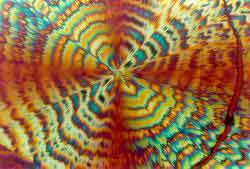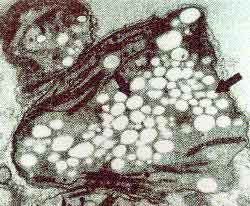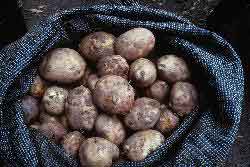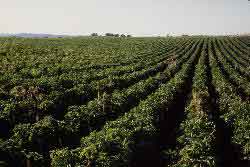It can be grown in plants. It can be eaten by bacteria. And it can be made into bottles
for shampoo. Is PHB the new miracle plastic? by Kathy Sykes
Do we need biodegradable
plastics?
Just in the UK, we produce enough plastic to fill the Royal Albert
Hall - three times every single day. That's about six million tonnes
a year. And most plastics last indefinitely, taking thousands of
years to disintegrate. If the Romans had made plastic, we'd still
have their waste with us today. If we don't want our great-grandchildren
to have to live on mounds of old plastic, we should try to address
the issue.
Recycling plastic is an option, and works well for bottles, but it can cost more in
energy terms than using virgin plastic. Burning waste plastic to harness the energy is
another option, but the gases released by some plastics are very toxic. The case for
biodegradable plastics is strong, especially where packaging gets dirty and can't be
re-used.
Several plastics masquerade as biodegradable, but actually break down into tiny
invisible bits that could affect the soil and animals such as earthworms. Of the few
plastics that are genuinely biodegradable, many contain toxic residues from catalysts. One
plastic, that's biodegradable and contains no nasty residues, is called PHB,
polyhydroxybutyrate.
Bugs make plastic
'Bugs make plastic' ran the headline when PHB was first commercialized in the early
eighties. Most plastics are made from oil but this one is made naturally, all the time, by
bacteria. And the supply is limitless. Almost any kind of bacteria store up energy as
'fat' available to be used later by the bacteria. When extracted, this bacteria fat
solidifies into a polymer very similar to traditional plastics like polythene. To make PHB
on a big scale you just fatten up bacteria with glucose in giant fermenters and
effectively 'brew' the plastic.
Not only do they make it - bacteria can eat it. PHB is so rich in energy for bugs, they
can't resist it. A discarded piece of PHB will be gobbled up by bacteria in the
environment. The time it takes for PHB to degrade just depends on the concentration of
bacteria: in the sea it takes PHB a few months to break down; in a sewage works it takes
just a few weeks; but on your kitchen or bathroom shelf, it will last decades.

Jamie Hobbs
PHB cystals spiral out from a central point forming beautiful Spherulites
|
Why isn't PHB filling up our supermarket shelves?
Here is a biodegradable material that could be used for many things: shampoo bottles,
plastic cups and packaging materials. But currently it's used for very little. One major
factor limiting PHB's use is its brittleness. Drop a brick into a PHB shopping bag and it
breaks. The other main factor limiting PHB's use is the cost: we'd have to pay a few pence
extra for products packaged in PHB. But there are a few places where PHB is used. The US
Navy, having despaired of trying to prevent staff throwing drinking containers overboard,
has opted to use PHB cups. Now the sailors are free to throw their empty cups into the
waves. In Japan, PHB has found its way into people's bathrooms and appears in the form of
disposable razors. Apparently some Japanese women are so uncomfortable about body hair
they remove every bit of it. The discretion surrounding the whole activity requires that
the razors be thrown down a toilet, and instantly flushed away. PHB's rapid degradation in
sewage clearly makes it the right choice.
PHB's success in market penetration could be greatly improved with new governmental
legislation. A UN convention in 1973 required that all material thrown directly into the
sea must be biodegradable, and it was this gradually coming into force that got the US
navy interested in PHB. The Italian government taxes every non-biodegradable plastic bag
250 lira (about 15 US cents), and the Danish government has banned non-recyclable beverage
containers. If moves like these continue, there's a better chance that we'll see PHB in
our supermarkets.
Even if biodegradable plastics start to be used extensively our waste won't completely
disappear. The places where our rubbish is supposed to end up, land-fill sites, are
notoriously bad at enabling anything to degrade - even paper lasts decades. There aren't
enough bacteria because there isn't enough oxygen around to keep them alive. Large-scale
composting facilities will be needed and these cost money.
Using PHB in the Body
Since the bacteria in our own stomachs make PHB to store energy our bodies don't reject
it. PHB can be used in medicine, in sutures for example, where the body gradually replaces
PHB over time. The plastic could also be used as a material that slowly releases drugs
into the body. After surgical implantation, its gradual degradation releases locked-in
drugs, right at the point where they are needed most. The fact that the human body accepts
PHB, means that you could eat the wrapper along with the chocolate bar.
Beautiful crystals
Plastic bags may not look or feel very crystalline, but if you zoom into a plastic bag
by a factor of a million, you can actually see lots of tiny crystals. These little
crystals form regular structures themselves: they spiral out from a central point, forming
little spheres called 'spherulites'. The crystals spiral completely regularly, and the
resulting spherulite structures can be incredibly beautiful.
For years, polymer physicists used polythene, or more correctly polyethylene, as a
model to represent the behaviour of other polymers. But over the last 20 years some
scientists have opted to use PHB instead. It crystallises more slowly than polyethylene,
and so is easier to study. It's been a remarkably useful material, and many new
discoveries have been made thanks to its big, slowly-forming crystals.
An unanswered question
PHB is everywhere. Trace amounts in short chains of only about 150 units have been
found in the cells of yeast, carrots, spinach, sheep, pigs, cattle and even in humans. It
exists in the cells of a staggering variety of different organisms. In fact, it seems that
you can find PHB in any cell that you care to choose, if you look hard enough. And nobody
knows what it's there for. Surely, for something to be so ubiquitous, it must have some
function. It's inconceivable that it's just an accident that PHB is present in so many
places. Some scientists have even claimed that PHB could be as important as proteins and
that HB units (hydroxy butyrate) might have been present in the primordial soup on earth,
before amino acids and proteins. These claims may be extravagant, but whatever the real
story is, watch this space; PHB must do something significant in cells.
It grows on trees...almost
A recent development in the PHB story has perhaps changed its destiny forever. A team
at the DoE Plant research lab at Michigan State University considered that there might be
a faster way of making PHB. In 1992, they took two genes from PHB-making bacteria and
inserted them directly into two cress plants and then crossed them. Some of the offspring
plants incorporated both the new genes and produced PHB in their leaves. They had managed
to create a plant that could grow plastic.

Chris Somerville
White PHB blobs inside a cressleaf
|
There were problems -the new cress plants were pathetic: their growth was severely
stunted. The leading geneticist Chris Sommerville (by now at the Carnegie Institute,
Washington), wanted to try out an unusual idea. He decided to add more DNA to the cress
plants, but this time from a pea plant. It worked. Now instead of PHB being manufactured
randomly over the plant's leaves, it was only made in one place, the chloroplasts, and the
plant's growth was completely normal. The PHB formed 14% of the dry weight of the leaves.
Now some scientists are trying to do
the same thing in potatoes so it's easier to harvest the PHB. It's quite a nice thought,
plastic coming from fields of potatoes instead of from oil refineries. But scientists
really are not yet sure about how easy it is to confine genetically modified plants in one
area, or about the impact so much PHB would have on the environment. It's too early yet to
risk growing PHB on a large scale outdoors.
 |

PhotosToGo
Factories of the Future?
|
The future for PHB
There's a real need for biodegradable plastics. PHB has a myriad of potential uses and
scientific interest has been steadily growing since it became easily available in the
early eighties. Despite this, it seems its future is very uncertain.
In 1996 Monsanto bought all patents for making PHB from ICI/Zeneca. But Monsanto's
fermenters producing PHB from bacteria were closed down at the start of last year. That
doesn't mean that Monsanto had given up on PHB, quite the opposite -instead they had high
hopes for producing PHB from plants instead of bacteria. But now with so much media
attention on GM crops, there has been little news of Monsanto's plans for PHB.
All the scientists who've been working on PHB are hoping that Monsanto
will keep producing the PHB that they need for their research. Whatever
the future for PHB, I'm pretty sure this intriguing plastic will
hit the news again in the not too distant future.
Copyright © FirstScience.com
|
